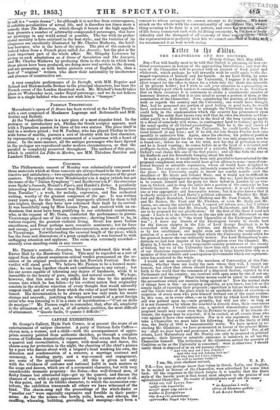CAFFRE EXHIBITION.
St. George's Gallery, Hyde Park Corner, is at present the scene of an entertainment of unique character. A party of thirteen Zulu Caffins- eleven men, a woman, and a child—with the accompaniment of appro- priate scenery painted from authentic sketches, go through a complete course of Caffreism dramatically represented. The return from the hunt, a quarrel and reconciliation, a supper, with meal-song and dance, the charm-song for protection in the night, the chanting of the chiefs praises by a poet who dances about with a leopard's head masking his own, the detection and condemnation of a sorcerer, a marriage contract and ceremony, a hunting party, and a war-council and engagement, are some of the principal scenes. All this is given not only with the vividness of costume and national habit in such matters as the songs and dances, which are of a ceremonial character, but with very • considerable dramatic propriety : the Zulus—fine well-formed men, of fleshy frames but attenuated legs—get up the quarrel, and discuss the chances of war, with a great appearance of being in earnest about it all. In this point, and in its lifelike character, to which the accessories con- tribute, the exhibition transcends all others we have witnessed of the kind. The charm-song and the proceedings of the witch-finder or "smeller out" were especially expressive and forcible in their panto- mime. As for the noises—the howls, yells, hoots, and whoops, the Muffling, wheezing, bubbling, grovelling, and stamping—they form concert to whose savagery we cannot attempt to do struck on the whole with the conventionality of unci thing seeming to be done to a set pattern, and even of life being transacted each with its fitting ceremony, viduality and the disregard of all economy of time a the representation is perfectly bona fide we cannot ente we recommend it as well worth seeing.


























 Previous page
Previous page